With Halloween fast approaching, now’s a great time to make sure you’re well stocked for an evening (or more) of horror movie viewing. Whether scouring streaming services, sorting through your physical media collection, or perusing the shelves of your local big box store, favored indie retail shop, or (if you’re lucky) mom & pop video store, here are some recommendations to scratch any itch:
Vampires
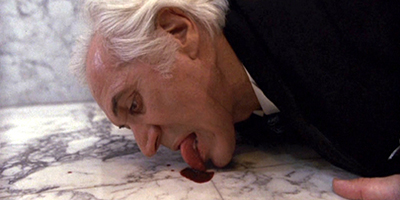 Though Christopher Lee’s Count Dracula didn’t return for Hammer’s first Dracula sequel, Brides of Dracula (1960), Peter Cushing’s Van Helsing did, and the film stands as one of Hammer’s best vampire films. (It’s now available on Blu-Ray as part of Universal’s Hammer Horror 8-Film Collection box set.) Tom Holland’s Fright Night (1985 – accept no remakes) perfectly balances comedy with horror in a very fun retro-monster movie to combat the 80’s slasher trend, with William Ragsdale and Roddy McDowall – playing aging horror star Peter Vincent – battling the vampire (Chris Sarandon) who’s moved in next door. Years later, Guillermo del Toro would make his debut with Cronos (1993), but rather than following the traditions by the letter, he reinvented the vampire (not for the last time). The elderly owner of an antiques shop comes into possession of an ancient device invented by an alchemist which grants eternal life – while draining his blood via sharp claws that dig into his flesh. He soon develops a craving for blood, while being pursued by a decrepit industrialist and his lackey son (a hilarious – and bilingual! – Ron Perlman). The final, surprisingly moving image is an homage to the original Nosferatu. Criterion has released the film on Blu-Ray, both individually and now as part of the box set “Trilogía de Guillermo del Toro” (alongside The Devil’s Backbone and Pan’s Labyrinth).
Though Christopher Lee’s Count Dracula didn’t return for Hammer’s first Dracula sequel, Brides of Dracula (1960), Peter Cushing’s Van Helsing did, and the film stands as one of Hammer’s best vampire films. (It’s now available on Blu-Ray as part of Universal’s Hammer Horror 8-Film Collection box set.) Tom Holland’s Fright Night (1985 – accept no remakes) perfectly balances comedy with horror in a very fun retro-monster movie to combat the 80’s slasher trend, with William Ragsdale and Roddy McDowall – playing aging horror star Peter Vincent – battling the vampire (Chris Sarandon) who’s moved in next door. Years later, Guillermo del Toro would make his debut with Cronos (1993), but rather than following the traditions by the letter, he reinvented the vampire (not for the last time). The elderly owner of an antiques shop comes into possession of an ancient device invented by an alchemist which grants eternal life – while draining his blood via sharp claws that dig into his flesh. He soon develops a craving for blood, while being pursued by a decrepit industrialist and his lackey son (a hilarious – and bilingual! – Ron Perlman). The final, surprisingly moving image is an homage to the original Nosferatu. Criterion has released the film on Blu-Ray, both individually and now as part of the box set “Trilogía de Guillermo del Toro” (alongside The Devil’s Backbone and Pan’s Labyrinth).
Black Magic
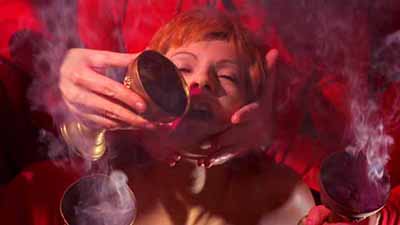 Dennis Wheatley’s series of black magic-themed thrillers featured the Duke de Richleau, a Van Helsing-style occult expert, portrayed perfectly on-screen by Christopher Lee in the top-tier Hammer outing The Devil Rides Out (1968); it’s an ideal film to watch prime time on Halloween. Fritz Leiber’s story of a dutiful wife who practices black magic behind the back of her husband, Conjure Wife, became a fascinating, Richard Matheson-scripted thriller, Burn, Witch, Burn (aka Night of the Eagle, 1962). And a classic M.R. James short story was the inspiration for the film noir-meets-the-supernatural Night of the Demon (1957). But after the trick ‘r’ treaters have stopped ringing the doorbell, and the rum-laced-apple cider has gone to your head, you could try the gonzo Black Magic Rites (1973), an anything-goes Italian mash-up of Satanism, vampirism, and sexploitation, all set to a killer main theme and lit with lush colors, and featuring dialogue like, “Vampires need blood that’s not contaminated by human semen!”
Dennis Wheatley’s series of black magic-themed thrillers featured the Duke de Richleau, a Van Helsing-style occult expert, portrayed perfectly on-screen by Christopher Lee in the top-tier Hammer outing The Devil Rides Out (1968); it’s an ideal film to watch prime time on Halloween. Fritz Leiber’s story of a dutiful wife who practices black magic behind the back of her husband, Conjure Wife, became a fascinating, Richard Matheson-scripted thriller, Burn, Witch, Burn (aka Night of the Eagle, 1962). And a classic M.R. James short story was the inspiration for the film noir-meets-the-supernatural Night of the Demon (1957). But after the trick ‘r’ treaters have stopped ringing the doorbell, and the rum-laced-apple cider has gone to your head, you could try the gonzo Black Magic Rites (1973), an anything-goes Italian mash-up of Satanism, vampirism, and sexploitation, all set to a killer main theme and lit with lush colors, and featuring dialogue like, “Vampires need blood that’s not contaminated by human semen!”
Wax Museums
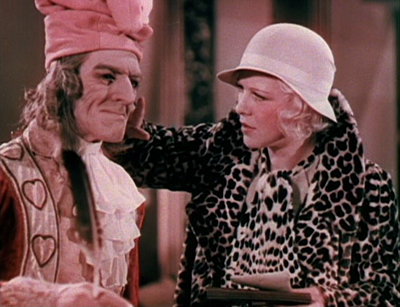 If you have the opportunity to watch Vincent Price’s House of Wax (1953) in 3-D, do. Otherwise you’ll be stuck with a scene where a man flings a yo-yo at the camera for a long minute without any particular urge to duck. The film helped kick-start Price’s second career as a horror star, and it’s a full-color, full-hammy, full-fun 3-D spectacular. But dig back earlier and you’ll discover a gem: Mystery of the Wax Museum (1933). Along with its cinematic twin brother Doctor X (1932), the film was made using an early two-color Technicolor process, was directed by Casablanca‘s Michael Curtiz, and features Lionel Atwill and the first scream queen, Fay Wray. The wax museum and its historical and ghoulish figures are creepy, but the film is also funny, with a wonderful performance by Glenda Farrell (Little Caesar) as the kind of fast-talking, effortlessly witty investigative reporter that only the screwball 30’s could produce. Available (along with Doctor X and others) in Warner’s Hollywood’s Legends of Horror box set.
If you have the opportunity to watch Vincent Price’s House of Wax (1953) in 3-D, do. Otherwise you’ll be stuck with a scene where a man flings a yo-yo at the camera for a long minute without any particular urge to duck. The film helped kick-start Price’s second career as a horror star, and it’s a full-color, full-hammy, full-fun 3-D spectacular. But dig back earlier and you’ll discover a gem: Mystery of the Wax Museum (1933). Along with its cinematic twin brother Doctor X (1932), the film was made using an early two-color Technicolor process, was directed by Casablanca‘s Michael Curtiz, and features Lionel Atwill and the first scream queen, Fay Wray. The wax museum and its historical and ghoulish figures are creepy, but the film is also funny, with a wonderful performance by Glenda Farrell (Little Caesar) as the kind of fast-talking, effortlessly witty investigative reporter that only the screwball 30’s could produce. Available (along with Doctor X and others) in Warner’s Hollywood’s Legends of Horror box set.
Hauntings
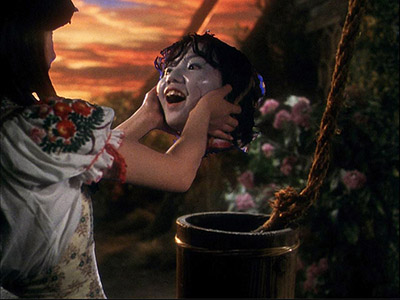 The haunted house tale is my favorite subgenre, and perennial favorites include The Innocents (1961), The Haunting (1963), and The Legend of Hell House (1973). For something more late-night, the once-obscure Japanese film House (1977) – now a proud part of the Criterion Collection – features a deadly ghost and a funhouse of an Old Dark House, all rendered like a live action cartoon. It’s a rarity: a major studio (Toho) turning over the keys to an anarchic, upstart director, a Beyond the Valley of the Dolls for the horror genre. For a more serious Japanese ghost story, Kuroneko (1968), also on Criterion, tells a savage, dream-like fable of a vengeful spirit murdering samurai when she’s not taking the shape of a black cat. Kwaidan (1964) tells multiple ghost stories in a colorful and surreal prestige epic.
The haunted house tale is my favorite subgenre, and perennial favorites include The Innocents (1961), The Haunting (1963), and The Legend of Hell House (1973). For something more late-night, the once-obscure Japanese film House (1977) – now a proud part of the Criterion Collection – features a deadly ghost and a funhouse of an Old Dark House, all rendered like a live action cartoon. It’s a rarity: a major studio (Toho) turning over the keys to an anarchic, upstart director, a Beyond the Valley of the Dolls for the horror genre. For a more serious Japanese ghost story, Kuroneko (1968), also on Criterion, tells a savage, dream-like fable of a vengeful spirit murdering samurai when she’s not taking the shape of a black cat. Kwaidan (1964) tells multiple ghost stories in a colorful and surreal prestige epic.
Monster Mashes
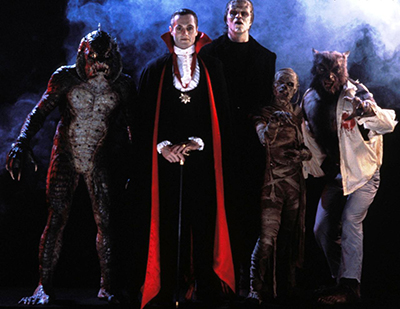 Famously, toward the end of the Universal Studios monster cycle, they began to mix and match their monsters in films like Frankenstein Meets the Wolf Man (1943) and House of Frankenstein (1944) – essentially establishing a shared universe decades before Marvel. Perhaps the most entertaining of these is Abbott and Costello Meet Frankenstein (1948), even if it spelled the ending of taking the monsters seriously. In the film, the comedy duo meet Dracula (Bela Lugosi, in a rare reprise of the Count), the Wolf Man (Lon Chaney Jr., in his best-loved role), Frankenstein’s Monster (Glenn Strange), and even The Invisible Man (Vincent Price, in a voice-only cameo). The Bowery Boys Meet the Monsters (1954) was a less classy, but nonetheless amusing monster mash, one of an endless series of Bowery Boys movies. Decades later, screenwriter Shane Black (Lethal Weapon) and director Fred Dekker (Night of the Creeps) shopped a script nostalgically reuniting the Universal Monsters, but when Universal turned it down, they went with more generalized treatments of such characters as Dracula, Frankenstein’s Monster, a Mummy, a Wolf Man, and even a Gill Man (most certainly not the Creature from the Black Lagoon). The Monster Squad (1987) was essentially “The Goonies meet the Monsters.”
Famously, toward the end of the Universal Studios monster cycle, they began to mix and match their monsters in films like Frankenstein Meets the Wolf Man (1943) and House of Frankenstein (1944) – essentially establishing a shared universe decades before Marvel. Perhaps the most entertaining of these is Abbott and Costello Meet Frankenstein (1948), even if it spelled the ending of taking the monsters seriously. In the film, the comedy duo meet Dracula (Bela Lugosi, in a rare reprise of the Count), the Wolf Man (Lon Chaney Jr., in his best-loved role), Frankenstein’s Monster (Glenn Strange), and even The Invisible Man (Vincent Price, in a voice-only cameo). The Bowery Boys Meet the Monsters (1954) was a less classy, but nonetheless amusing monster mash, one of an endless series of Bowery Boys movies. Decades later, screenwriter Shane Black (Lethal Weapon) and director Fred Dekker (Night of the Creeps) shopped a script nostalgically reuniting the Universal Monsters, but when Universal turned it down, they went with more generalized treatments of such characters as Dracula, Frankenstein’s Monster, a Mummy, a Wolf Man, and even a Gill Man (most certainly not the Creature from the Black Lagoon). The Monster Squad (1987) was essentially “The Goonies meet the Monsters.”
Extraterrestrials
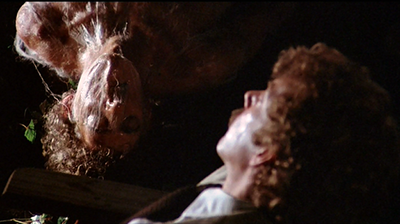 Philip Kaufman’s Invasion of the Body Snatchers (1978) is the rare remake that’s as good as the original (if not better). The film is both a respectful tribute to the 1957 Don Siegel classic (Kevin McCarthy reprises his most famous scene) and an intelligent updating to a modern milieu, adding to its palette 70’s political and social paranoia. Donald Sutherland, Brooke Adams, Leonard Nimoy, Jeff Goldblum, and Veronica Cartwright make for a very appealing cast, and the direction is consistently unnerving. John Carpenter’s The Thing (1982) successfully remakes a different 50’s alien invasion film, but this time pays closer attention to the original source, John W. Campbell’s “Who Goes There?” The physical effects are terrifyingly real. On its 30th anniversary, it’s also a good time to revisit James Cameron’s Aliens (1986), another example of a follow-up that does more than rehash its source material. True, it does shift its genre more toward 80’s action, but don’t overstate it: this is still a horror film, with a mounting feeling of unease, a slowburn that patiently builds toward spectacular – and nightmarish – confrontation. All three films have brand new special edition releases available on Blu-Ray.
Philip Kaufman’s Invasion of the Body Snatchers (1978) is the rare remake that’s as good as the original (if not better). The film is both a respectful tribute to the 1957 Don Siegel classic (Kevin McCarthy reprises his most famous scene) and an intelligent updating to a modern milieu, adding to its palette 70’s political and social paranoia. Donald Sutherland, Brooke Adams, Leonard Nimoy, Jeff Goldblum, and Veronica Cartwright make for a very appealing cast, and the direction is consistently unnerving. John Carpenter’s The Thing (1982) successfully remakes a different 50’s alien invasion film, but this time pays closer attention to the original source, John W. Campbell’s “Who Goes There?” The physical effects are terrifyingly real. On its 30th anniversary, it’s also a good time to revisit James Cameron’s Aliens (1986), another example of a follow-up that does more than rehash its source material. True, it does shift its genre more toward 80’s action, but don’t overstate it: this is still a horror film, with a mounting feeling of unease, a slowburn that patiently builds toward spectacular – and nightmarish – confrontation. All three films have brand new special edition releases available on Blu-Ray.
Killer Families
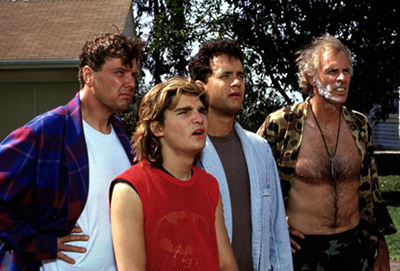 If you’ve watched The Texas Chain Saw Massacre (1974) too many times, now might be a good time to revisit its oddball sequel, The Texas Chainsaw Massacre II (1986). Tobe Hooper took the film as a contractual obligation, but used the opportunity to both send up the original film and take it in new, stranger directions. For a more family friendly option, spend some time with Joe Dante’s cult classic horror comedy The ‘Burbs (1989). Tom Hanks (back when he exclusively made comedies) suspects that his new neighbors – who just moved into a crumbling old house that violates all the aesthetic rules of this perfectly manicured community – might be murderers in the style of the Leatherface clan. Bruce Dern, Carrie Fisher, Rick Ducommun, Corey Feldman, and Henry Gibson provide some very good laughs.
If you’ve watched The Texas Chain Saw Massacre (1974) too many times, now might be a good time to revisit its oddball sequel, The Texas Chainsaw Massacre II (1986). Tobe Hooper took the film as a contractual obligation, but used the opportunity to both send up the original film and take it in new, stranger directions. For a more family friendly option, spend some time with Joe Dante’s cult classic horror comedy The ‘Burbs (1989). Tom Hanks (back when he exclusively made comedies) suspects that his new neighbors – who just moved into a crumbling old house that violates all the aesthetic rules of this perfectly manicured community – might be murderers in the style of the Leatherface clan. Bruce Dern, Carrie Fisher, Rick Ducommun, Corey Feldman, and Henry Gibson provide some very good laughs.
Halloween on Screen
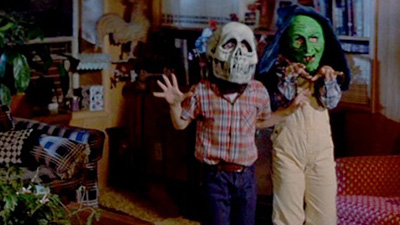 Once maligned, now considered a seasonal favorite, Halloween III: Season of the Witch (1982) relegates Michael Myers to a cameo (Halloween is playing on a TV), and instead boldly suggests that the franchise should become an anthology series. That didn’t take thanks to unenthusiastic audiences, which leaves this film an anomaly: using a story by John Carpenter and Quatermass Xperiment screenwriter Nigel Kneale, writer/director Tommy Lee Wallace (Stephen King’s It) presents a horror story with elements of both science fiction and the supernatural, digging into the origins of the holiday and using child-killing Halloween masks sold by Silver Shamrock with a ubiquitous jingle that’s an earworm in the most unpleasant sense. In recent years, actual Halloween anthology Trick ‘r’ Treat (2007) has become a bona fide cult classic, and deservedly so. Of course, the original Halloween (1978) presents the holiday definitively, but for a more off the beaten path (and downright offbeat) treatment, see The Pit (1981).
Once maligned, now considered a seasonal favorite, Halloween III: Season of the Witch (1982) relegates Michael Myers to a cameo (Halloween is playing on a TV), and instead boldly suggests that the franchise should become an anthology series. That didn’t take thanks to unenthusiastic audiences, which leaves this film an anomaly: using a story by John Carpenter and Quatermass Xperiment screenwriter Nigel Kneale, writer/director Tommy Lee Wallace (Stephen King’s It) presents a horror story with elements of both science fiction and the supernatural, digging into the origins of the holiday and using child-killing Halloween masks sold by Silver Shamrock with a ubiquitous jingle that’s an earworm in the most unpleasant sense. In recent years, actual Halloween anthology Trick ‘r’ Treat (2007) has become a bona fide cult classic, and deservedly so. Of course, the original Halloween (1978) presents the holiday definitively, but for a more off the beaten path (and downright offbeat) treatment, see The Pit (1981).
Zombies Before Romero
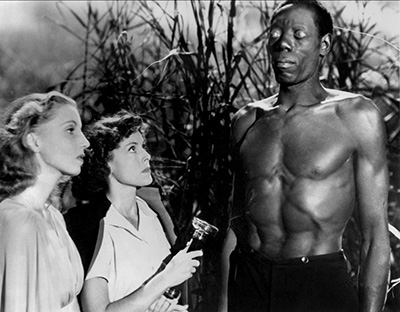 Look, flesh-eating zombies all came from Romero, right? And now we can’t have anything else, apparently. But if you’re looking for a return to old-school, voodoo-conjured zombies, you can’t go wrong with the Bela Lugosi classic White Zombie (1932), the eerie Hammer horror The Plague of the Zombies (1966), or – my personal favorite – the haunting I Walked with a Zombie (1943). One of the standout films in the Val Lewton cycle of atmospheric RKO chillers, the sensationalist title is here wedded to a Jane Eyre-inspired storyline set in Haiti and directed by the masterful Jacques Tourneur (Cat People, Night of the Demon). The most subdued zombie film ever made, Tourneur nonetheless lends every poetic image a weight and authentic supernatural power.
Look, flesh-eating zombies all came from Romero, right? And now we can’t have anything else, apparently. But if you’re looking for a return to old-school, voodoo-conjured zombies, you can’t go wrong with the Bela Lugosi classic White Zombie (1932), the eerie Hammer horror The Plague of the Zombies (1966), or – my personal favorite – the haunting I Walked with a Zombie (1943). One of the standout films in the Val Lewton cycle of atmospheric RKO chillers, the sensationalist title is here wedded to a Jane Eyre-inspired storyline set in Haiti and directed by the masterful Jacques Tourneur (Cat People, Night of the Demon). The most subdued zombie film ever made, Tourneur nonetheless lends every poetic image a weight and authentic supernatural power.
Art House via the Grindhouse
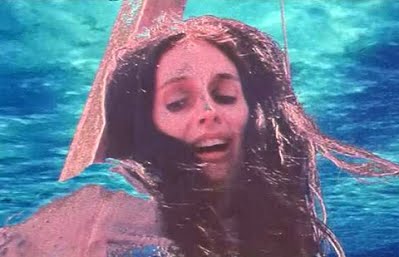 Jean Rollin’s debut feature film, the black-and-white, improv-jazz-scored The Rape of the Vampire (1968), is the only one of his vampire films which fits right alongside the most experimental films of the French New Wave. And yet it also establishes rules for his admired (and more cohesive) vampire films that followed, including gratuitous nudity and bloodletting. It’s adventurous late night viewing, just like The Witch Who Came from the Sea (1976). Witch was marketed with one of the great bait-and-switch exploitation posters. The art (partially copied/ripped-off from a Frazetta Vampirella cover) features a semi-nude witch standing astride a rock amidst crashing waves, wielding a bloody scythe and holding the severed head of one of her victims. “Molly really knows how to cut men down to size!” is the tagline. What moviegoers would have discovered inside the grindhouse was a surprisingly sensitive portrayal of a sexual abuse survivor (Millie Perkins of The Diary of Anne Frank) whose rigid morality is at odds with her fantasies of sleeping with athletic men and then castrating them with a razor blade. Then she discovers that these fantasies might actually be real. The title is a reference to Greek mythology, and the birth of Aphrodite from the severed genitals of her titan father. Director Matt Cimber (aided by cinematographer Dean Cundey) treats the shocking elements with matter-of-fact grit, while maintaining a dream-like feel via jarring, Easy Rider-style cuts or abrupt, surreal juxtapositions (a nightmarish clown on a black-and-white TV; Perkins half-naked getting a tattoo from the man who once sent her recoiling in fear). Available from Arrow on Blu-Ray and DVD in the American Horror Project Volume 1 box set.
Jean Rollin’s debut feature film, the black-and-white, improv-jazz-scored The Rape of the Vampire (1968), is the only one of his vampire films which fits right alongside the most experimental films of the French New Wave. And yet it also establishes rules for his admired (and more cohesive) vampire films that followed, including gratuitous nudity and bloodletting. It’s adventurous late night viewing, just like The Witch Who Came from the Sea (1976). Witch was marketed with one of the great bait-and-switch exploitation posters. The art (partially copied/ripped-off from a Frazetta Vampirella cover) features a semi-nude witch standing astride a rock amidst crashing waves, wielding a bloody scythe and holding the severed head of one of her victims. “Molly really knows how to cut men down to size!” is the tagline. What moviegoers would have discovered inside the grindhouse was a surprisingly sensitive portrayal of a sexual abuse survivor (Millie Perkins of The Diary of Anne Frank) whose rigid morality is at odds with her fantasies of sleeping with athletic men and then castrating them with a razor blade. Then she discovers that these fantasies might actually be real. The title is a reference to Greek mythology, and the birth of Aphrodite from the severed genitals of her titan father. Director Matt Cimber (aided by cinematographer Dean Cundey) treats the shocking elements with matter-of-fact grit, while maintaining a dream-like feel via jarring, Easy Rider-style cuts or abrupt, surreal juxtapositions (a nightmarish clown on a black-and-white TV; Perkins half-naked getting a tattoo from the man who once sent her recoiling in fear). Available from Arrow on Blu-Ray and DVD in the American Horror Project Volume 1 box set.









